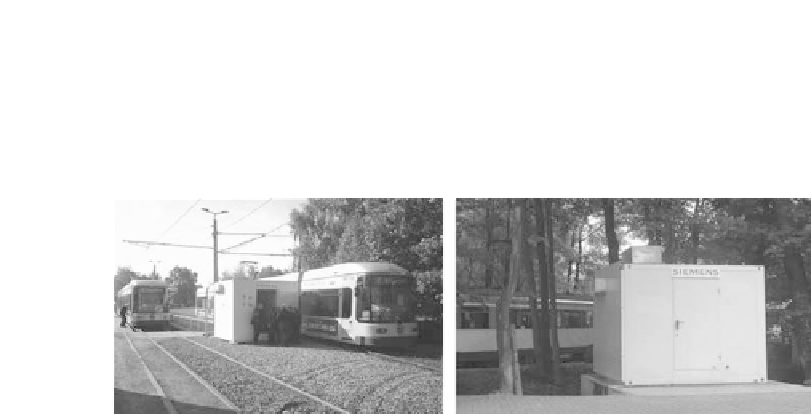Environmental Engineering Reference
In-Depth Information
Cologne and Madrid are using the Sitras system that applies ultra-capacitor mod-
ules to a trackside unit, as shown in Figure 2.42. Each trackside unit consists of
1344 Boostcap ultra-capacitor cells rated 2,600 F, operating at 2.3 V and delivering
a power level of 1 MW at 95% efficiency. The system reliability requirement is
22 h/day operation and maintenance free for 10 years.
Figure 2.42 Trackside RESS using ultra-capacitors - Siemens Sitras system
2.7.3 Ultra-capacitor trolley bus vehicles
Trolley bus is another example of where wayside or third rail regenerative energy
storage can make a substantial impact on system reliability, up-time as well as
substantial energy savings.
Many trolley buses were converted to dual mode for flexibility in navigating
tunnels and intersections. Later the dual mode was abandoned in favour of hybrid
technology and more recently of battery-electric mode. The 2008 Beijing Olympic
buses are one notable example of battery-electric buses used to transport teams,
managers and officials to events.
The battery only electric bus developed for the 2008 Beijing Olympics was the
result of a 10 year effort by the Beijing Institute of Technology (BIT) and 20 other
organizations, including the Beijing Bus Corp. The team focused on overall energy
efficiency, the need for zero emissions and fast turnaround of depleted batteries.
To do this the BIT team devised the robotized battery swap system shown in
Figure 2.43 that pulled a depleted lithium ion battery tray from the bus and replaced
with a fresh charged pack from the charging racks as shown. This swapping
operation of battery packs took less than 8 min per bus and the bus was back in
service. The battery recharge and swap facility was located along the bus route.
2.8 Electric four wheel drive
Another advancement that has been facilitated by electric propulsion systems is the
flexibility to drive one or more axles using independent electric traction motors,
either as stand-alone units with half-shaft coupling or as in-wheel motors as dis-
cussed earlier in this chapter.








